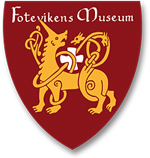Agricultural plants in the Viking Age
Background
Finds of pollen and seeds at archaeological excavations have in recent years shown that there were significatly more types of agricultural plants in Scandinavia during the Viking Age than previously assumed. It was long assumed that most agricultural plants were introduced with the monasticism.
This idea had its base in the dated idea of the North as a culturally poor area before Christianity. An idea that formed as the Church and Christianity tried to sweet everything pagan under the rug and replace old values and knowledge. This resulted in Christianity appearing as the spreader of new knowledge to the Nordic people. The new finds contradict this idea.
During a period of about 250 years, from 700 to early 1000 AD, contacts with various parts of Europe was extensive, through plundering and trade. During this period the Vikings likely brought seeds, cuttings and scions from foreign plants and introduced them home in Scandinavia.
Among the finds from the Viking Age there are several plats previously considered to be brought in during the Middle Ages by the monasteries, such as opium poppy (Papaver somniferum), henbane (Hyoscyamus niger), marsh mallow (Althea officinalis). Other evidence that the cultural exchange was significant during the Viking Age is finds of fruits and seeds indicating import, such as stone pine (Pinus pinea), peach (Prunus persica) and grape vine (Vitis vinifera).
Plant list
The list below contains plats that may have been cultivated in a Danish Viking Age kitchen garden:
Ground elder (Aegopodium podagraria)
Opium poppy (Papaver somniferum)
Marsh mallow (Althea officinalis)
Pea (Pisum arvense)
Garden angelica (Angelica archangelica)
Elderberry (Sambucus nigra)
Celery (Apium graveolens)
Common soapwort (Saponaria officinalis)
Cabbage (Brassoca oleracea)
White mustard (Sinapis alba)
Creeping bellflower (Campanula rapunculoides)
Common comfrey (Symphyrum officinalis)
Chicory (Cichorium intybus)
Valerian (Valeriana officinalis)
Coriander (Coriandrum sativum)
Common vervain (Verbena officinalis)
Hensbane (Hyoscyamus niger)
Horse bean (Vici faba)
Roundleaved mint (Mentha x rutundifolia)
Ground elder (Aegopodium podagraria)
This intractable plant is fortunately a useful plant. The leaves have an aromatic taste and can either be stewed as spinach or eaten raw in sallads. It was originally brought to our country to be cultivated as a vegetable. As the species latin name "podagraria" indicates the ground elder has been a popular antidote toward podager (gout). The mashed plant was placed on sore feet.
Marsh mallow (Althea officinalis)
Originally comes from the area around the Caspian Sea. In Sweden it can very rarely be found on beach meadows in Scania and Blekinge, and occasionally around Lake Vänern. The root is dug up after 2 years in March, while flowers and leaves are harvested in June. The roots can be boiled and eaten as a vegetable.
The plant contains statch and sugar and the root is very slime rich. During the Viking Age it was known that the marsh mallow was expectorant and a soothing cough mixture. Hildegard of Bingen who lived in the 12th century (born 1098 AD) advocatted the marsh mallow as a remedy for fever and headache. Today the marsh mallow is used against catarrh in the respiratory tracts, dry cough and mouth and throat irritations.
Hensbane (Hyoscyamus niger)
The hensbane is among the very oldest poison and healing plants. All parts of the plant are extremely toxic. The hensbane poison, hyoscyamin and scopolamin, affects the central nervous system. The poison can be absorbed through the skin and can cause hallucinations. Hensbane also contains anticonvulsant substances and is used today to treat asthma, nervous diseases, muscle spasms and shaking.
The narcotic and numbing effects of the hensbane has been known since antiquity and has been used as a soporific and anesthetic. The Gauls used hensbane juice for poison arrows and it was known very long ago that the hensbane could cause severe thirst, double vision, convulsions, unbridled fury and insanity. The herb as also used by priests and diviners to get into a trance and extatic state. An example is the well known oracle of Delphi who after consuming hensbane reached a hysterical state during which the famed prophecies were uttered.
The hensbane was likely mostly spread by nomads, but also by monks. Eventually the herb spread everywhere the nomands went by dropping seeds along the way, or even intentionally planting them to have the plant close at hand. It may also have been used to sedate hens during poultry thefts to prevent their cackling from alerting their owners.
Garden angelica (Angelica archangelica)
Garden angelica is a Nordic beach and mountain plant and is the only healing herb that has been exported wordwide from Scandinavia. When the Nordic Vikinga emigrated to the Faroes, Iceland and Orkney Islands they brought Garden angelica. It is still common to serve Garden angelica stems and leaves with dry fish and meat.
Garden angelica is rich in vitamin C and has was thus a good nutrition supplement during the Viking Age. If the harvest failed and four was scarce the root could be dug up, dried and milled into flour. Garden angelica has an unusually aromatic taste and smell as it contains several etheric oils and sugars. The boiled roots are the tastiest in autumn, when they contain the most sugar. Garden angelica can also be used as a sweetener in sourish fruit dishes.
Celery (Apium graveolens)
The celery originates, like many of our kitchen plants, in western Asia. Stem celery today grows in the wild along beaches from southern Europe all the way up to Denmark. Celery is grown for its brittle, tasty stems and spicy leaves. The leaves can also be used fresh or dried as a vegetable and spice.
Celery was grown both as food and medicinal plant by ancient Egyptians, Greeks and Romans, and it was in large part the Romans who contributed to its spread across Europe. During the Viking Age both the root and fruit were used as an aphrodisiac and, according to Hildegard of Bingen, also as a remedy to gout, watery eyes and blood purification.
Cabbage (Brassica oleracea ssp.)
Wild growing cabbage (Brassica oleracea var. silvestris) occur on the beach of Southern and Western Europe. Its closest currently cultivated relative is the kale.
Field pennycress - Smells and tastes like garlic
Parsnip
Creeping bellflower - The roots are dible and taste like vinegar
Burdock - The stems can be boiled and eaten like asparagus
Onion
Pepperwort - Strong taste of cress, were used instead of pepperroot or mustard
Plants that according to finds were grown in Lund about 1050 - 1300 AD:
Hensbane
Hyssop
Milk thistle
Black mustard
Garden cress
Rapeseed
Dill
Garden orache
Lesser meadow-rue
Radish
Rue
Motherwort
Summer savory
Winter savory
Lettuce
Hop
Lungwort
Agrimony
Meadow clary















